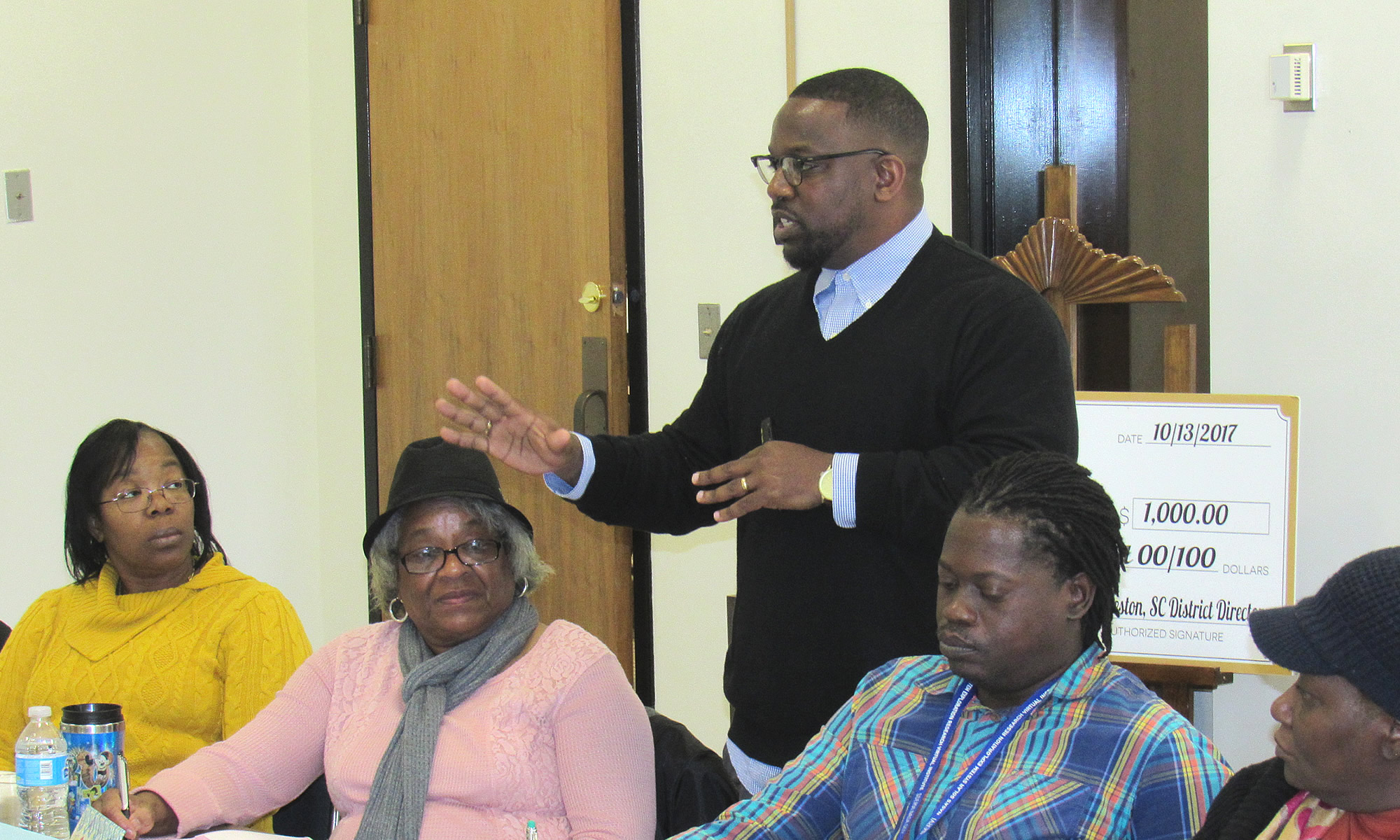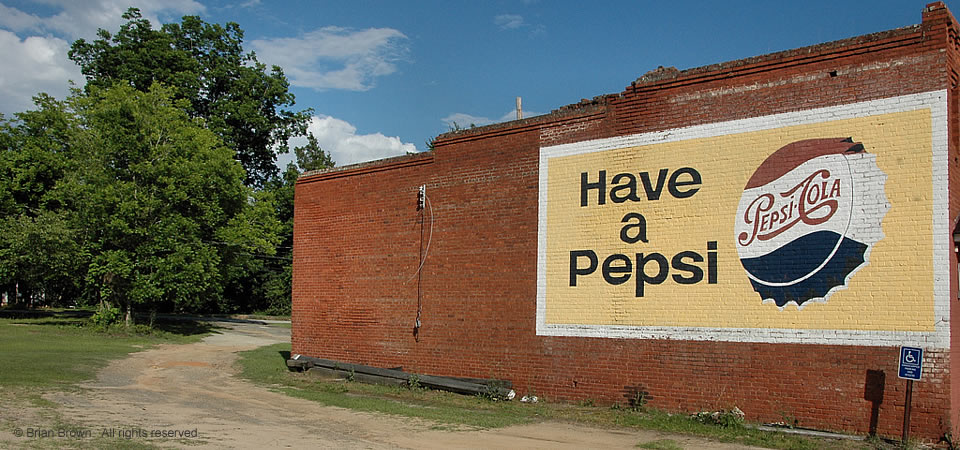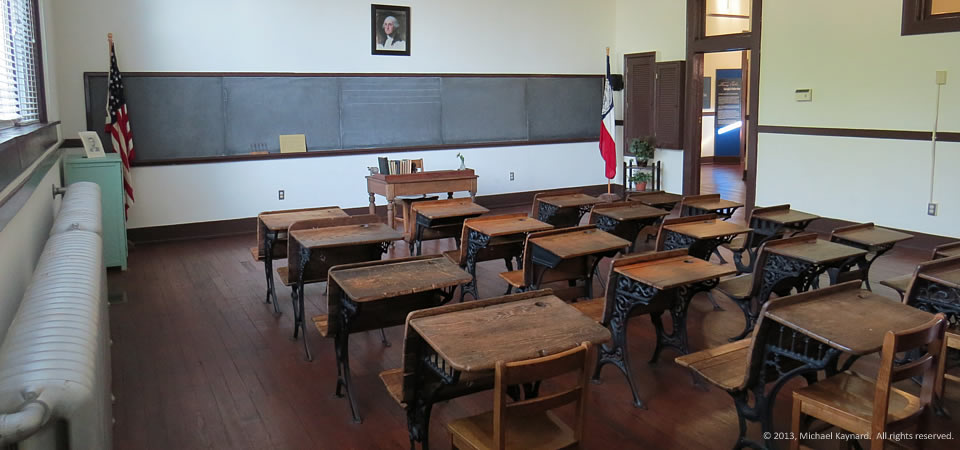
Cotton, Emanuel County, Ga.
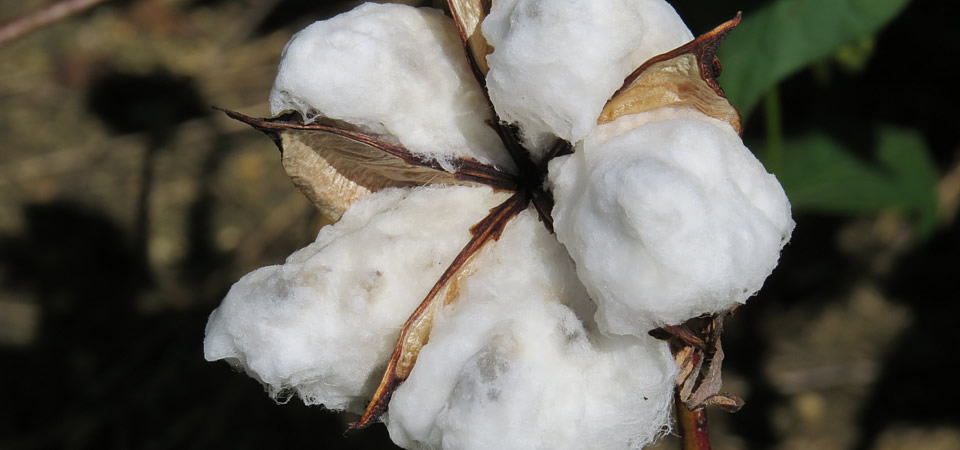
Cotton is bustin’ out all over the South, but particularly in the fields of middle Georgia, the state that grows the most cotton in the Southern Crescent region. According to the Cotton Council International 2013 Buyers’ Guide, Georgia farmers grew more than 15 percent of the nation’s cotton in 2011-12 by producing 2.465 million bales. The only state that grew more cotton was Texas, which produced 3.5 million of the nation’s 15.573 million bales in 2011-12.
This photo was taken just north of the intersection of U.S. Highway 80 and Georgia Highway 121 in Emanuel County, which has almost 23,000 people and a poverty rate of 24.5 percent, according to the U.S. Census.
Photo taken Sept. 23, 2013, by Michael Kaynard. All rights reserved.
Melton store, Allentown, Ga.
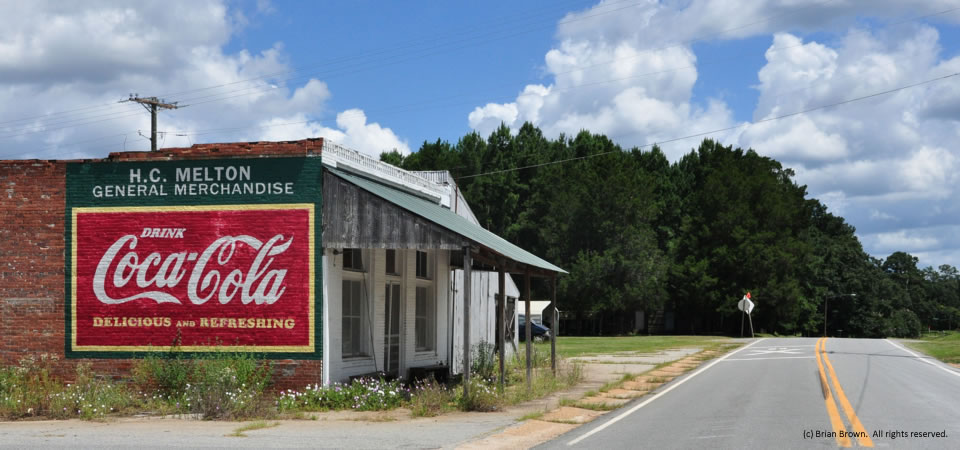
From Better South President Andy Brack:
My Great Uncle Gordon Brack used to be a clerk in this store in Allentown in rural Wilkinson County, Georgia, where my father was a boy. Thanks to Brian Brown of the Vanishing South Georgia project for letting us republish the photo.
My dad, Elliott Brack, recalls the store in the 1940s:
“We used to buy soft drinks for five cents out of a cooler chilled by ice, pulling the drinks out of the cold water. If we had another nickel, we would buy peanuts and pour them into the Coke or RC or Pepsi for added pleasure.”
Dad says the store had a butcher and a meat market. “Items were on shelves and you told them you wanted something and the counterman reached up and got it. No self-self service much. They were general merchandise, which meant they sold feed and overalls too.”
Brown notes in his post about the store that Allentown is known for being at the intersection of four Georgia counties, although it mostly is in Wilkinson County.
Today, Wilkinson County has fewer people (9,577 in the 2012 Census estimate) than it did in the 1940s (11,025 people) when my dad was a boy here before moving to the “big city” of Macon with his family. About three in five people are white, with most of the rest being black. Poverty is about 20 percent.
- More from QuickFacts from the U.S. Census.
- More from Wikipedia.
Copyrighted photo by Brian Brown. Used by permission. All rights reserved.
Old store, Bartow, Ga.
Vanishing South Georgia photographer Brian Brown offers this 2010 Pepsi image from Bartow, Ga. The photo serves to balance an earlier post of a Coca Cola advertising mural in Mount Vernon, Ga., which is about an hour south.
“The mural at Bartow is on a building that was once a thriving local grocery store,” Brown says. “Bartow has always been a small town, with a scattering of churches and businesses, but as is the case in so many of these places, all that remains is the advertising to even suggest that it was once a gathering place.”
Bartow (population 286) is in Jefferson County, a Crescent county with an estimated 16,432 people in 2012. Some 54 percent of residents are black, with almost all of the remaining people in the rural county being white. About 29 percent of people live in poverty.
2010 photo, copyrighted by Brian Brown. All rights reserved.
Walking down the street, Lumber City, Ga.
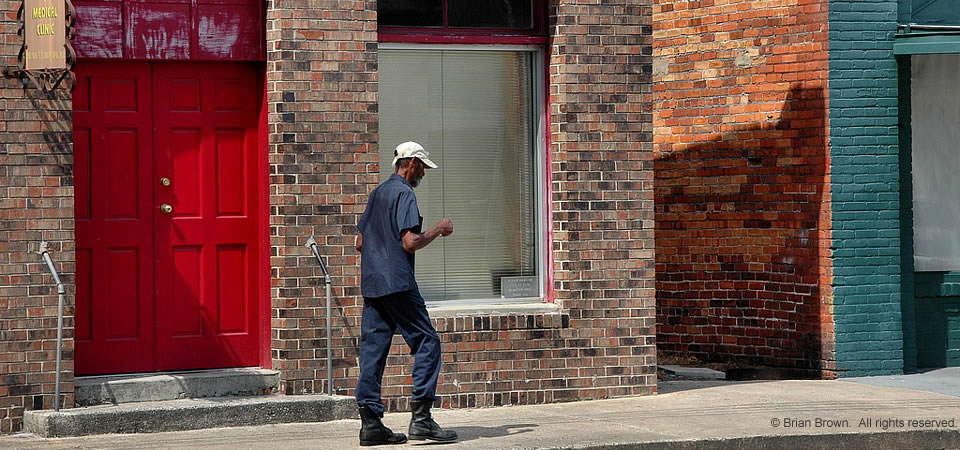
Vanishing South Georgia photographer Brian Brown offers this photo of a pedestrian walking down a Lumber City, Ga., street that has a medical clinic behind the bright red doors.
Lumber City has about 1,300 people, a third of whom live in poverty. It’s on the eastern tip of Telfair County, which as 16,349 people, according to the 2012 Census estimate. Just over 60 percent of residents are white. About 36 percent are black. About 13 percent of people consider themselves to be Hispanic or Latino. As with Lumber City, a third of the county’s population lives in poverty.
2012 copyrighted photo by Brian Brown. All rights reserved.
Family farm, Owensboro, Ga.
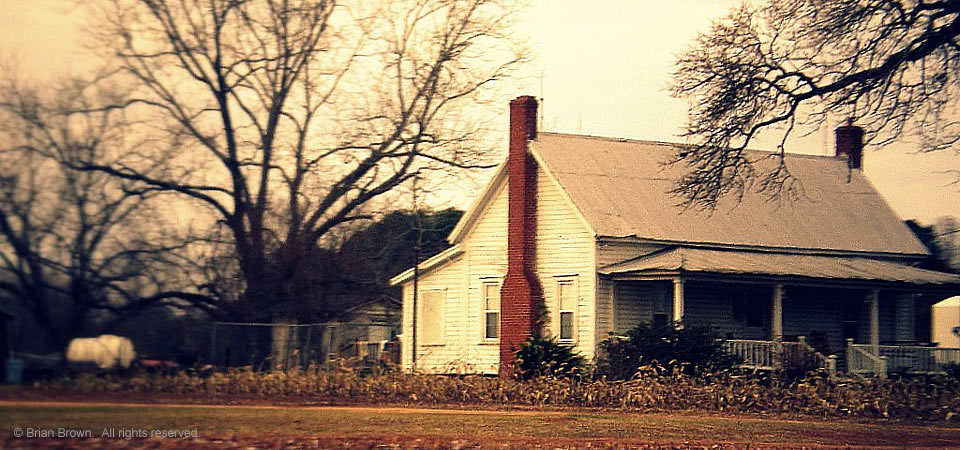
For Georgia photographer Brian Brown, this family farmhouse near Owensboro, Ga., represents the heart of small-family farming operations.
“Owensboro is a ghost town today, with nothing but fields and farming, but once supported several businesses and many more families lived there fifty years ago than do today,” Brown writes.
Owensboro is in Wilcox County, one of the Peach State’s smaller counties with 9,068 residents, according to the U.S. Census. About two thirds of residents are white and a third black. Estimates by the U.S. Census are that 27.4 percent of county residents live in poverty.
2008 photograph courtesy of Brian Brown, VanishingSouthGeorgia.com. All rights reserved.
Old depot, Plains, Ga.
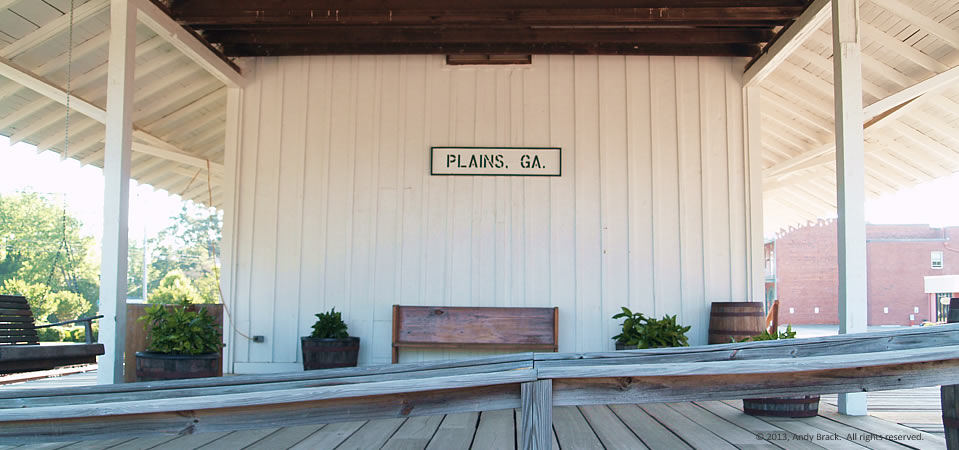
This old train platform in Plains, Ga., is preserved at the Jimmy Carter National Historic Site to highlight what an old train depot used to look like. The other end of the building was the first campaign headquarters for Carter’s 1976 successful bid for the presidency.
We liked how the Park Service kept this part of the depot because it recalls simpler, slower times without all of the hustle and bustle of modern life (cell phones, computers, GPS, etc.)
Plains, about 15 miles west of Americus in Georgia’s agricultural heartland, had 776 people in 2010, according to the Census. Three in five residents are black, with whites comprising almost all of the rest. About a quarter of the population lives below the poverty line.
- More about Plains.
- Learn about the Jimmy Carter Library and Museum in Atlanta
- Learn about the Carter Center in Atlanta
Photograph taken May 15, 2013, by Andy Brack, Center for a Better South. Copyright 2013. All rights reserved.
Campaign headquarters, Plains, Ga.
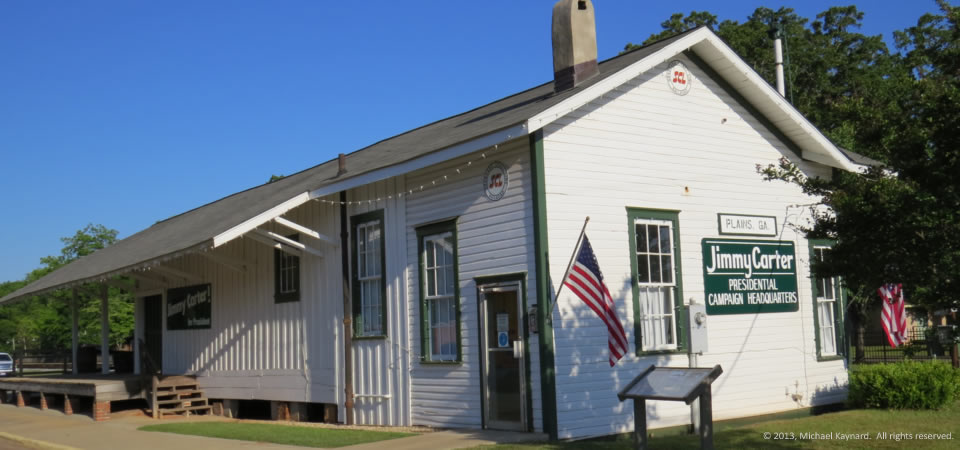
In 1975 in this old train depot in Plains, Ga., former President Jimmy Carter started what some thought would be an unlikely presidential campaign. The depot, now part of the Jimmy Carter National Historic Site, reportedly operated from 1888 to 1951 in this town of about 700. Carter and his wife, Rosalynn, grew up in Plains.
Photographer Michael Kaynard noted, “There is a block of tourist businesses just down from the train depot Carter used as his campaign headquarters. Other attractions include his boyhood farm, Plains High School, Billy Carter’s gas station, Rosalynn Carter’s family home and the private Carter compound. Some of the land is being used for agriculture but it would be bypassed except for its ties to the President and his family.”
Plains, whose public school system was absorbed into that of nearby Americus and Sumter County, had 776 people in 2010, according to the Census. Three in five residents are black, with whites comprising almost all of the rest. About a quarter of the population lives below the poverty line.
- More about Plains.
- Learn about the Jimmy Carter Library and Museum in Atlanta
- Learn about the Carter Center in Atlanta
Photograph taken May 15, 2013, by Michael Kaynard, Kaynard Photography. Copyright 2013. All rights reserved.
Presidential classroom, Plains, Ga.
Former President Jimmy Carter went to school in this Plains, Ga., classroom at Plains High School, now the museum and visitors’ center at the Jimmy Carter National Historic Site.
To our knowledge, this is the only federal presidential historic site in the Southern Crescent. All over town, it’s easy to see commonalities with other rural communities across the Crescent — small-town life dominated by agriculture and a close-knit community.
Photographer Michael Kaynard noted, “There is a block of tourist businesses just down from the train depot Carter used as his campaign headquarters. Other attractions include his boyhood farm, Plains High School, Billy Carter’s gas station, Rosalynn Carter’s family home and the private Carter compound. Some of the land is being used for agriculture but it would be bypassed except for its ties to the President and his family.”
Plains, whose public school system was absorbed into that of nearby Americus and Sumter County, had 776 people in 2010, according to the Census. Three in five residents are black, with whites comprising almost all of the rest. About a quarter of the population lives below the poverty line.
- More about Plains.
- Learn about the Jimmy Carter Library and Museum in Atlanta
- Learn about the Carter Center in Atlanta
Photograph taken May 15, 2013, by Michael Kaynard, Kaynard Photography. Copyright 2013. All rights reserved.
Empty car dealership, Claxton, Ga.
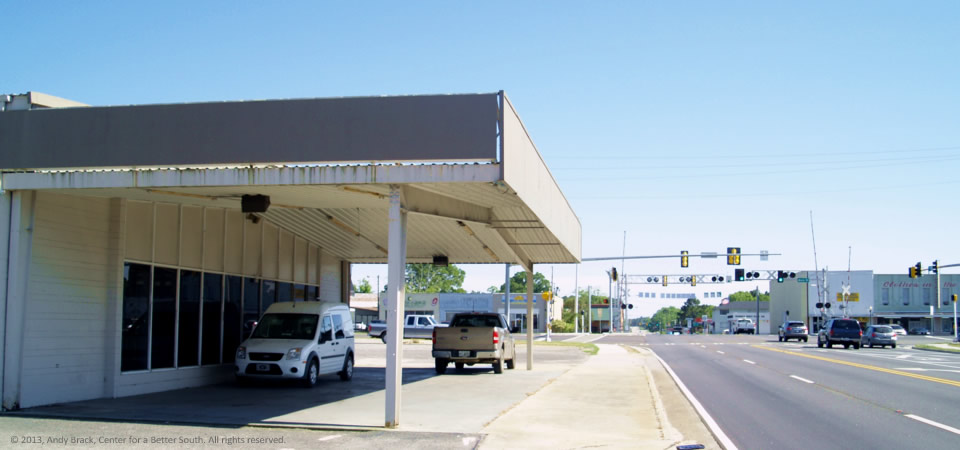
Claxton, Ga., known for its fruitcakes and annual rattlesnake roundup, is one of many rural Southern towns that features an empty, old car dealership. In the background, you can see the town’s main stoplight at the intersection of Main and Duval streets, also known as the crossing of U.S. highways 301 and 280.
Some of the businesses in towns like Claxton moved out of the central business district to the outskirts to capitalize on Wal-Marts that drained downtown activity. Some of them just closed.
Claxton, county seat for Evans County, is located about 50 miles west of Savannah, Ga.
While Claxton has about 2,200 residents, Evans County is home to an estimated 10,689 residents, a slight drop from the 11,000 people recorded in the 2010 Census. Some 22 percent of Evans County residents live below the federal poverty level. The average per capita income is $18,547.
Photo is from May 2013 and is copyrighted by Andy Brack, Center for a Better South. All rights reserved.
